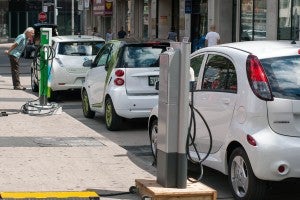 You may have noticed: we’re big fans of electric vehicles (EVs) here at Environmental Defense Fund (EDF). Standard transportation fuels are one of the biggest sources of harmful greenhouse gas emissions, so vehicle electrification is a crucial part of our clean energy future. But getting more EVs on the road is about more than just giving customers incentives to buy these types of vehicles. We also need to deal with where and how we charge EVs.
You may have noticed: we’re big fans of electric vehicles (EVs) here at Environmental Defense Fund (EDF). Standard transportation fuels are one of the biggest sources of harmful greenhouse gas emissions, so vehicle electrification is a crucial part of our clean energy future. But getting more EVs on the road is about more than just giving customers incentives to buy these types of vehicles. We also need to deal with where and how we charge EVs.
From April 27th to May 4th, EDF was engaged in evidentiary hearings at the California Public Utilities Commission that dealt with San Diego Gas & Electric’s (SDG&E) new electric vehicle pilot. Representatives from EDF, the Utility Consumers’ Advocacy Network, the Office of Ratepayer Advocates, SDG&E, Pacific Gas & Electric, ChargePoint, KnGrid, the Natural Resources Defense Council, and the Green Power Institute, were all putting their best foot forward at the hearings. While there were sadly no Perry Mason moments (aside from an unsilenced cell phone playing the theme song in the middle of the hearings), I did try my hand at challenging witnesses on some key points through cross-examination for the first time. More importantly, the six-day-long process allowed Jamie Fine to shine as an expert witness and raise a number of matters of high priority to EDF.
- Placement of Charging Infrastructure. While some parties advocated for focusing placement of infrastructure at workplaces or multi-unit dwellings, EDF agrees with SDG&E that both areas are currently underserved and deserving of attention. Though there is evidence that EV drivers prefer to charge at home, having access to workplace charging is important for allowing drivers to get to and from their job without having to worry about running out of battery. In addition, charging at work during the day will allow for the use of increasing amounts of solar energy, which is good for the grid and the environment.
- Use of a Dynamic Rate. Putting more electric vehicles on the road can have enormous benefits in terms of reducing harmful emissions. However, in order to maximize these positive climate impacts, charging must be done in a way that takes full advantage of renewable energy for charging and ensures the grid is not burdened by the added electricity needs of these vehicles. This can be accomplished by establishing a dynamic rate, such as the one proposed by SDG&E, that incentivizes charging during times when there is an abundance of wind or solar on the grid. While parties disagreed as to the efficacy of the rate proposed by SDG&E, evidence shows customers respond to a price signal. This situation is no different – especially since the price signal is likely to get stronger in the future.
- Preservation of Competition. Third-party companies that provide charging services are understandably concerned that utilities’ ownership of charging infrastructure could dampen the competition. We support utility ownership of charging infrastructure in order to increase deployment of charging stations and, as a result, electric vehicles – as well as effectively pass a price signal onto EV drivers. Put another way, at least for right now, EDF believes that a utility presence can help “jumpstart” the market in a way that puts California back on track to meeting its ZEV mandate. However, we also encourage the Commission to put metrics in place that ensure a market complete with third parties and innovative ideas, particularly as the need for charging stations grows to fit a bigger EV population.
- Realization of Ratepayer Benefits. EDF believes that because SDG&E’s pilot has the potential to realize benefits for all customers as a result of fewer transportation emissions – resulting in reduced health impacts, particularly important in the disadvantaged communities that are most affected – EDF is not as against the idea of this pilot being funded through utility bills. However, there is an important caveat: if SDG&E is asking its customers to take on some risk, they can’t get off scot-free.
All in all, EDF sees SDG&E’s pilot as a way to potentially increase use of EVs in the state – which will be a critical part of meeting California’s climate and clean energy goals. As we approach 2020, it will be necessary to test out a variety of different approaches, including the programs proposed by Southern California Edison and Pacific Gas & Electric, to see what actually serves to deploy more EVs in the state in the most effective way possible. Despite differences that were showcased at the hearing, there is agreement that we need to start planning for a clean future now. Even though I may not have gotten a Perry Mason opportunity to object to anything in a dramatic manner, that’s a pretty powerful take-away from this hearing.
Photo source: Wiki Commons









